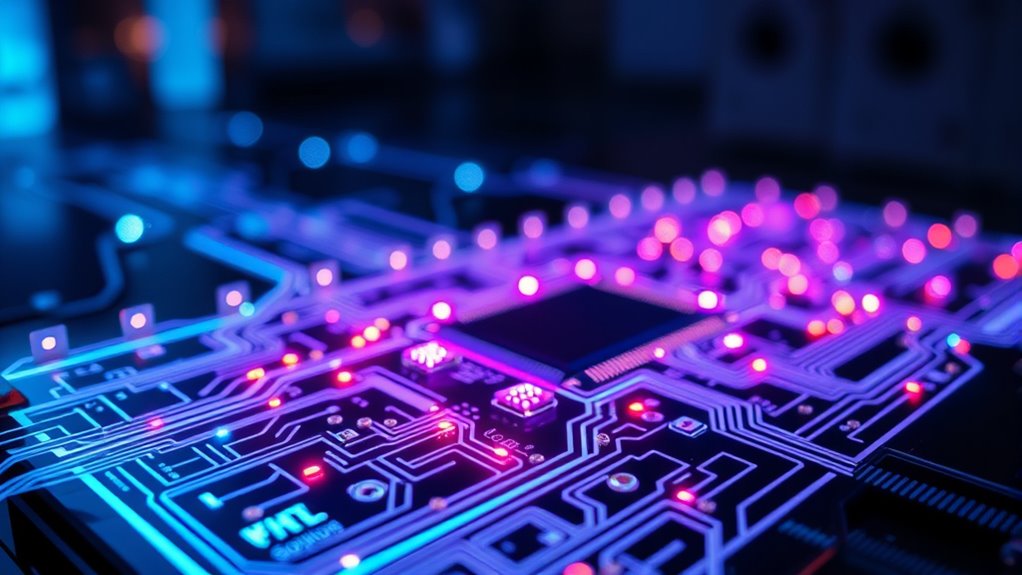Light-based chips are revolutionizing AI by offering faster processing speeds, greater energy efficiency, and scalable design. They use light instead of electrical currents, enabling tasks to be completed in fractions of a nanosecond while consuming less power. With their ability to handle advanced AI models and integrate seamlessly into existing systems, these chips promise a cleaner, more powerful future. If you want to see how this technology is shaping tomorrow, there’s more to explore.
Key Takeaways
- Photonic chips perform AI computations at speeds under 0.5 nanoseconds, enabling faster processing.
- They significantly reduce power consumption, leading to more energy-efficient AI systems.
- Capable of integrating advanced AI models without modification, enhancing scalability and versatility.
- Use light to represent nonlinear functions, essential for complex neural network training.
- Their compatibility with existing manufacturing processes supports large-scale, sustainable AI hardware development.

Have you ever wondered how light could revolutionize computing? With recent advances in photonic chips, it’s becoming clear that light-based technology could dramatically transform artificial intelligence. Unlike traditional electronic chips that rely on electrical currents, photonic processors use light to perform complex computations. This shift offers not only faster processing speeds but also considerably greater energy efficiency. Because photons travel at the speed of light, these chips can complete machine-learning tasks in less than half a nanosecond, all while consuming less power. For example, a newly developed photonic processor can execute deep neural network operations with over 92% accuracy—comparable to conventional electronic systems—yet does so at a fraction of the energy cost. It achieves this feat while running at 65.5 trillion 16-bit adaptive block floating-point operations per second, consuming just 78 watts of electrical power and 1.6 watts of optical power. Such efficiency opens the door for AI systems that are faster, more powerful, and more sustainable. Additionally, premium home appliances designed with smart technology can further enhance the efficiency of modern living.
Photonic chips are already capable of running advanced AI models like ResNet, BERT, and DeepMind’s Atari reinforcement learning algorithms without needing any modifications. This versatility indicates that light-based computing can seamlessly integrate into existing AI workflows. Their high scalability and integration capacity are notable; packages include six chips with 50 billion transistors and nearly one million photonic components. This dense integration points to the potential for increasingly compact, powerful AI hardware. The advantages over traditional electronic chips are clear: photonic computing avoids resistive electrical losses, reduces heat dissipation, and broadens bandwidths for faster data transport. These qualities make photonic chips especially suited for bandwidth-heavy AI tasks, where speed and energy efficiency are critical.
Recent breakthroughs have pushed photonic computing closer to mainstream adoption. Researchers developed the first chip capable of representing nonlinear functions optically—an essential step for training deep neural networks. Previously, photonic chips could only perform linear operations, which limited their usefulness for AI learning. Overcoming this barrier, scientists achieved near 32-bit floating-point accuracy, enabling more precise and reliable AI computations. Additionally, lithography-free, programmable photonic chips now allow for flexible, rewritable optical pathways without fixed physical circuitry. This flexibility enhances adaptability and reduces manufacturing complexity. These innovations are fabricated using existing silicon foundry processes, paving the way for large-scale production and seamless integration with electronic components. Advanced packaging techniques, including vertical stacking and high-speed interconnects, further boost performance, making light-based chips a promising technology for the next generation of AI hardware.
In short, light-based chips could lead to a future where AI is faster, more energy-efficient, and more capable than ever before, transforming how we process information and paving the way for smarter, greener technology.
Frequently Asked Questions
How Do Light-Based Chips Compare in Cost to Traditional Silicon Chips?
Light-based chips are currently more expensive than traditional silicon chips due to complex manufacturing processes and specialized materials. However, as production scales up, especially with silicon photonics leveraging existing semiconductor infrastructure, costs can decrease markedly. You’ll find that high-volume applications, like AI, could benefit from reduced costs over time, but right now, the initial investment remains higher compared to conventional silicon chips.
What Are the Main Challenges in Commercializing Light-Based AI Chips?
You face several challenges in commercializing light-based AI chips. Precise manufacturing of optical components on silicon is complex and costly, making large-scale production difficult. Balancing energy efficiency with performance requires innovative design, while heat dissipation and reliability issues persist. High R&D costs and limited software tools hinder adoption. Additionally, supply chain disruptions and the need for industry collaboration slow down market entry, demanding significant investment and coordination.
How Do Light-Based Chips Affect Energy Consumption in Data Centers?
Your data center’s energy use could drop dramatically, with light-based chips reducing power consumption by up to 30 times compared to traditional tech. These chips generate less heat, cutting cooling needs and operational costs. They also enable denser computing and faster data transfer with minimal energy loss. By adopting photonics, you’re not just saving energy—you’re transforming your data center into an ultra-efficient, eco-friendly powerhouse that meets growing demands sustainably.
Are Light-Based Chips Compatible With Existing AI Hardware and Software?
Yes, light-based chips are compatible with your existing AI hardware and software. They integrate seamlessly with current CMOS silicon substrates and support popular AI models like ResNet and BERT without retraining. These chips perform core operations like convolutions and communicate via industry-standard protocols such as PCIe and CXL, making integration smooth. Plus, their energy efficiency reduces cooling needs, allowing you to upgrade systems without major redesigns or added costs.
What Industries Will Benefit Most From Adopting Light-Based Chip Technology?
You’ll find that industries like data centers, healthcare, autonomous vehicles, and telecommunications benefit most from adopting light-based chip technology. These sectors handle massive data processing, demand high energy efficiency, and require real-time insights. While some may worry about integration challenges, existing infrastructure can adapt smoothly. The advantages of faster, greener, and more reliable AI processing make these industries prime candidates for harnessing photonic chips’ full potential.
Conclusion
Imagine a future where these light-based chips become the heartbeat of our technology, guiding us toward a brighter, cleaner dawn. As you embrace this innovation, you’re stepping into a world where artificial intelligence flows as swiftly and pure as sunlight itself. This isn’t just progress—it’s a revolution illuminating the path forward, promising a smarter, greener tomorrow. With each photon-powered leap, you’re helping craft a future where technology and nature shine in harmony.









